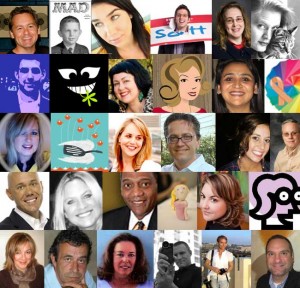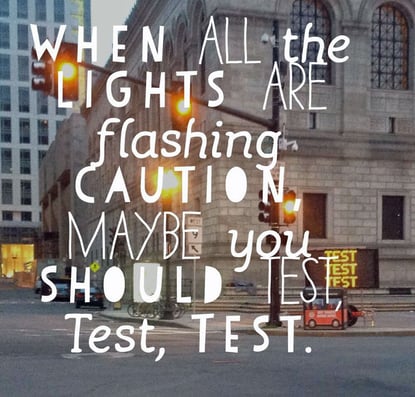I "met" Chris Griffiths on Twitter through chatting about audience-building strategies in social media. Chris is CEO of Think Buzan, the folks behind Mind Mapping. Today, Chris Griffiths is releasing his new book, "GRASP The Solution," a pragmatic guide to making decisions and solving problems creatively. From my tweeted request, Chris shared this guest post for Brainzooming readers on the value of focused daydreaming, a practical tool for creativity:
Imagine going into a meeting with the Board of Directors and suggesting that employees should spend some of their time in work daydreaming. How would they react?
My guess is that it wouldn’t be a popular idea!
Most people think of daydreaming as a waste of time – something you might do during lazy moments in between actually working. But I’m a firm believer that daydreaming can enhance creativity to a massive degree. Think about it. How many times do great ideas come to you when you’re in the shower, taking a walk or while driving? Well, you’re not alone. This happens to all of us. Many of the world’s greatest minds reached moments of true brilliance through the simple act of daydreaming. Here’s just a few:
- Sir Isaac Newton and his discovery of gravity
- Thomas Edison and his countless inventions
- Albert Einstein and his theory of relativity
In fact, Einstein was very outspoken about his love of daydreaming – or what he called his ‘thought experiments’. He even credited these ‘experiments’ for giving him the ideas that led to his greatest works.
Though I don’t claim to possess the genius of Einstein, I can definitely vouch for the benefits of daydreaming when searching for creative solutions and insights. There’ve been more than a few occasions when I’ve struggled for hours – and days even! – to solve a problem without any success. That’s when I know I need to stop aggressively forcing myself to find a solution, and instead just relax and let my mind wander. Sure enough, the solution soon comes to me, seemingly out of nowhere.
How can we make daydreaming work for us?
 You may be thinking by this point: “If daydreaming is so effective, why aren’t I coming up with brilliant ideas all the time?” It’s a fair question – after all, daydreaming is something we do every day. But we usually do it without any preparation and without a goal in mind. The key to using daydreaming as a creativity technique is to make it focused and deliberate, and to hold an awareness of what you want to achieve.
You may be thinking by this point: “If daydreaming is so effective, why aren’t I coming up with brilliant ideas all the time?” It’s a fair question – after all, daydreaming is something we do every day. But we usually do it without any preparation and without a goal in mind. The key to using daydreaming as a creativity technique is to make it focused and deliberate, and to hold an awareness of what you want to achieve.
Focused daydreaming requires some simple preparation to get the desired results. We need to first think about the problem and put all the groundwork in, getting to grips with the information and consciously exploring solutions. This helps to brief the deeper parts of the mind so the unconscious has lots to ponder. Then it’s just a case of switching off and letting your mind wander.
I like to do a lot of ‘mind wandering’ when I’m out travelling, whether I’m on a train, a plane or a car. But, and this is really important, I always pay close attention to any ideas that come up and note them down in a Mind Map or notepad. It’s no good having a brilliant idea and then immediately forgetting it!
There are loads of ways to get into the right state of mind for daydreaming, including:
- Taking a walk in the park
- Having a bath or shower
- Riding a bicycle or driving
- Lying awake in the morning or night
It’s well worth experimenting to find what works best for you.
The great Austrian composer Mozart would have his most creative moments when lying awake in the still of the night, warm and relaxed in bed. In a letter to his father he once wrote, “When I am completely myself, entirely alone or during the night when I cannot sleep, it is on these occasions that my ideas flow best and most abundantly. Whence and how these come I know not and nor can I force them.”
A good trick for creating the right mental climate for ideas to spring forth is to use Mindfulness. Mindfulness is the art of paying careful attention to the details of the present moment, without judgement. A simple way to do this is to take a leaf out of Leonardo da Vinci’s book and cultivate your senses. Learn to see through the eyes of an artist, to hear through the ears of a musician, to feel with the sense of a lover, to smell with the nose of a perfumist and taste with the palate of a chef. This exercise heightens your awareness in just 20 seconds and brings you into focus to look at your situation with lots more clarity.
What does the future hold for daydreaming?
Unfortunately, daydreaming doesn’t hold the same status in business as rational thinking. For most of us it’s simply out of bounds - our workplaces see it as a frivolous and time-wasting activity. But the tide is changing, and support for daydreaming as a tool for creativity is growing all the time. Even scientists have begun to swing in favour of it, with more and more studies proving that our brains are more active when we’re daydreaming than when we’re engaged in vigorous, conscious thought!
I could write a whole book on the benefits of focused daydreaming – but the best way to learn is to try it yourself. Next time you have a problem that needs a creative solution, or you just need some fresh ideas, stop forcing the issue and instead let your mind wander. You might just be surprised by the results. - Chris Griffiths



